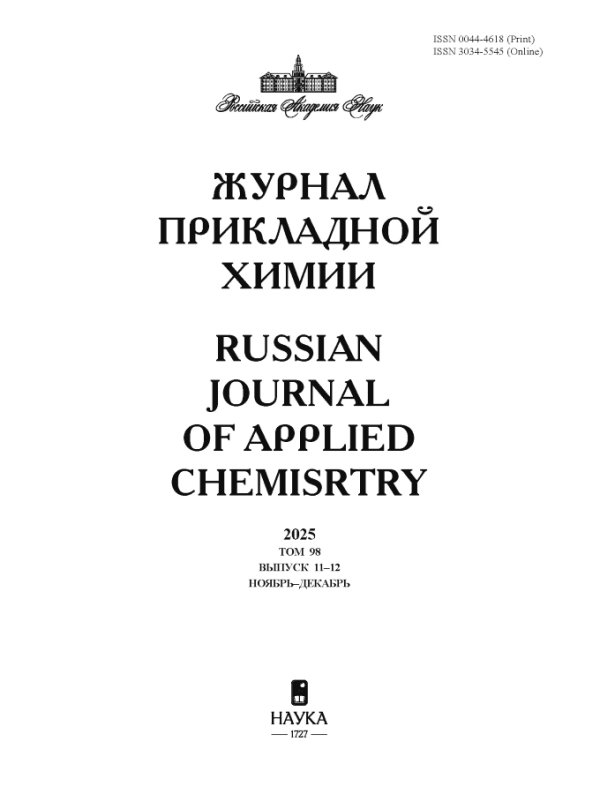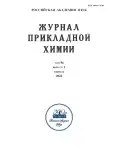Adsorption of Rhodamine G from Aqueous Solutions onto Particles of Few-Layer Graphene Prepared by Self-Propagating High-Temperature Synthesis
- Authors: Podlozhnyuk N.D.1, Voznyakovskiy A.A.1, Voznyakovskiy A.P.2, Kidalov S.V.1, Bogacheva E.A.1
-
Affiliations:
- Ioffe Physicotechnical Institute, Russian Academy of Sciences
- Lebedev Research Institute of Synthetic Rubber
- Issue: Vol 96, No 2 (2023)
- Pages: 209-216
- Section: Articles
- URL: https://journals.rcsi.science/0044-4618/article/view/247279
- DOI: https://doi.org/10.31857/S0044461823020093
- EDN: https://elibrary.ru/OURRFK
- ID: 247279
Cite item
Full Text
Abstract
The ability of few-layer graphene prepared by self-propagating high-temperature synthesis to adsorb Rhodamine G was studied. The dependences of the sorption capacity of few-layer graphene particles on the Rhodamine G concentration in aqueous solution, solution temperature, and adsorption time were determined. The adsorption of Rhodamine G on the surface of few-layer graphene is satisfactorily described by the Langmuir and Freundlich models. The process occurs under mixed diffusion control and can be described by a pseudo-second-order rate equation.
About the authors
N. D. Podlozhnyuk
Ioffe Physicotechnical Institute, Russian Academy of Sciences
Email: acjournal.nauka.nw@yandex.ru
194064, St. Petersburg, Russia
A. A. Voznyakovskiy
Ioffe Physicotechnical Institute, Russian Academy of Sciences
Email: acjournal.nauka.nw@yandex.ru
194064, St. Petersburg, Russia
A. P. Voznyakovskiy
Lebedev Research Institute of Synthetic Rubber
Email: acjournal.nauka.nw@yandex.ru
198035, St. Petersburg, Russia
S. V. Kidalov
Ioffe Physicotechnical Institute, Russian Academy of Sciences
Email: acjournal.nauka.nw@yandex.ru
194064, St. Petersburg, Russia
E. A. Bogacheva
Ioffe Physicotechnical Institute, Russian Academy of Sciences
Author for correspondence.
Email: acjournal.nauka.nw@yandex.ru
194064, St. Petersburg, Russia
References
- Zümriye A. Application of biosorption for the removal of organic pollutants: A Review // Proc. Biochem. 2005. V. 40 N 3. P. 997-1026. https://doi.org/10.1016/j.procbio.2004.04.008
- Hameed B. H., Din A. T. M., Ahmad A. L. Adsorption of methylene blue onto bamboo-based activated carbon: Kinetics and equilibrium studies //j. Hazard. Mater. 2007. V. 141. N 3. P. 819-825. https://doi.org/10.1016/j.jhazmat.2006.07.049
- Пьянова Л. Г., Корниенко Н. В., Седанова А. В., Лавренов А. В. Адсорбция ализаринового красного на техническом углероде // ЖПХ. 2021. Т. 94. № 5. С. 596-602. https://doi.org/10.31857/S0044461821050078
- Mingfei Z., Peng L. Adsorption of methylene blue from aqueous solutions by modified expanded graphite powder // Desalination. 2009. V. 249. N 1. P. 331-336. https://doi.org/10.1016/j.desal.2009.01.037
- Yunjin Y., Feifei X., Ming C., Zhongxiao X., Zhiwen Z. Adsorption behavior of methylene blue on carbon nanotubes // Bio. Tech. 2010. V. 101. N 9. P. 3040-3046. https://doi.org/10.1016/j.biortech.2009.12.042
- Hamdaoui O. Batch study of liquid-phase adsorption of methylene blue using cedar sawdust and crushed brick //j. Hazard. Mater. 2006. V. 135. N 1. P. 264-273. https://doi.org/10.1016/j.jhazmat.2005.11.062
- Liu T., Li Y., Dua Q., Suna J., Jiao Y., Yanga G., Wanga Z., Xia Y., Zhang W., Wang K., Zhu H., Wu D. Adsorption of methylene blue from aqueous solution by graphene // Col. Surf. B. 2012. V. 90. P. 197-203. https://doi.org/10.1016/j.colsurfb.2011.10.019
- Kong L., Enders A., Rahman T. S., Dowben P. A. Molecular adsorption on graphene //j. Phys. Condens. Matter. 2014. V. 26. P. 1-27. https://doi.org/10.1088/0953-8984/26/44/443001
- Кулакова И. И., Лисичкин Г. В. Перспективы применения графеновых наноматериалов: cорбенты, мембраны, газовые сенсоры (обзор) // ЖПХ. 2021. Т. 94. № 9. С. 1090-1103. https://doi.org/10.31857/S0044461821090012
- Zhao J., Wang Z., White J. C., Xing B. Graphene in the aquatic environment: Adsorption, dispersion, toxicity and transformation environ // Sci. Technol. 2014. V. 48. N 17. P. 9995-10009. https://doi.org/10.1021/es5022679
- Xu J., Cao Z., Zhang Y., Yuan Z., Lou Z., Xu X., Wang X. A Review of functionalized carbon nanotubes and graphene for heavy metal adsorption from water: Preparation, application, and mechanism // Chemosphere. 2018. V. 195. P. 351-364. https://doi.org/10.1016/j.chemosphere.2017.12.061
- Hossain F., Akther N., Zhou Y. Recent advancements in graphene adsorbents for wastewater treatment: Current status and challenges // Chin. Chem. Lett. 2020. V. 31. N 10. P. 2525-2538. https://doi.org/10.1016/j.cclet.2020.05.011
- Whitener K. E., Sheehanb E. Graphene synthesis // Diam. Relat. Mater. 2014. V. 46. P. 25-34. https://doi.org/10.1016/j.diamond.2014.04.006
- Voznyakovskii A., Vozniakovskii A., Kidalov S. New way of synthesis of few-layer graphene nanosheets by the self propagating high-temperature synthesis method from biopolymers // Nanomaterials. 2022. V. 12. N 4. ID 657. https://doi.org/10.3390/nano12040657
- Vozniakovskii A., Voznyakovskii A., Kidalov S., Osipov V. Structure and paramagnetic properties of graphene nanoplatelets prepared from biopolymers using self-propagating high-temperature synthesis //j. Struct. Chem. 2020. V. 65. P. 869-878. https://doi.org/10.1134/S0022476620050200
- Puskar L., Petit T. FTIR spectroscopy of nanodiamonds: Methods and interpretation // Diam. Relat. Mater. 2018. V. 89. P. 52-62. https://doi.org/10.1016/j.diamond.2018.08.005
- Li Y., Du Q., Wang X., Zhang P., Wang D., Wang Z., Xia Y. Removal of lead from aqueous solution by activated carbon prepared from Enteromorpha prolifera by zinc chloride activation //j. Hazard. Mater. 2010. V. 183. N 1. P. 583-589. https://doi.org/10.1016/j.jhazmat.2010.07.063
- Langmuir I. The adsorption of gases on plane surfaces of glass, mica and platinum //j. Am. Chem. Soc. 1918. V. 40. N 9. P. 1361-1403. https://doi.org/10.1021/ja02242a004
- Shams K., Sidqi A., Kamal M., Patil S. Surfactant adsorption isotherms: A Review // ACS Omega. 2021. V. 6. N 48. P. 32342-32348. https://doi.org/10.1021/acsomega.1c04661
- Freundlich H. Über die Adsorption in Lösungen // Zeitschrift für physikalische chemie. 1907. V. 57. N 1. P. 385-470. https://doi.org/10.1515/zpch-1907-5723
- Murugan M., Jansi M., Subramaniam P., Subramanian E. Use of activated carbon prepared from Prosopis spicigera L. wood (PSLW) plant material for the removal of rhodamine 6G from aqueous solution // Desalination Water Treat. 2016. V. 57. N 7 P. 3048-3058. https://doi.org/10.1080/19443994.2014.986204
- Wang C., Feng C., Gao Y., Ma X., Wu Q., Wang Z. Preparation of a graphene-based magnetic nanocomposite for the removal of an organic dye from aqueous solution // Chem. Eng. J. 2011. V. 173. N 1. P. 92-97. https://doi.org/10.1016/j.cej.2011.07.041
- Dong Z., Wang D., Liu X., Pei X., Chena L., Jin J. Bio-inspired surface-functionalization of graphene oxide for the adsorption of organic dyes and heavy metal ions with a superhigh capacity //j. Mater. Chem. A. 2014. V. 2. P. 5034-5040. https://doi.org/10.1039/C3TA14751G
- Хамизовa Р. Х. О кинетическом уравнении псевдо-второго порядка в сорбционных процессах // ЖФХ. 2020. Т. 94. № 1. С. 125-130. https://doi.org/10.31857/S0044453720010148
- Крижановская О. О., Синяева Л. А., Карпов С. И., Селеменев В. Ф., Бородина Е. В., Рёсснер Ф. Кинетические модели при описании сорбции жирорастворимых физиологически активных веществ высокоупорядоченными неорганическими кремнийсодержащими материалами // Сорбцион. и хроматогр. процессы. 2014. Т. 14. № 5. С. 784-794. https://www.elibrary.ru/SXLCFF
Supplementary files










